If Portland is on the cusp of a new open streets era (and I think it is), it will be up to us to make it great. And by “us” I mean all of us — from city staffers to grassroots activists and everyone in between.
Especially the grassroots.
That’s because the way Portland is doing this is different than other places (surprise, surprise). Our movement is being led by the community and the powers-that-be (the transportation bureau and City Hall) are merely facilitators.
That’s one of the big — and exciting — takeaways from our latest Wonk Night that happened on Wednesday at the Lancaster StreetLab.
With about 40 or so movers-and-shakers in the livable streets movement, we shared insights, traded ideas, and asked important questions about Portland’s open streets past, present, and future.
I’ve always had a sense that using streets as public spaces and for much more than moving automobiles around was in Portland’s DNA; but I had no idea our local open streets legacy was nearly 50 years old. At Wonk Night, southeast Portland resident Greg Raisman (he’s a bureau of transportation employee by day) told us about the Halprin project in southwest that includes a series of fountains and carfree plazas that were created in the 1970s.
Fast forward to more recent history and 2008 stands out as a watershed year: That’s when Portland transportation reform activist Elly Blue and a merry band of volunteers organized the International Towards Carfree Cities Conference, the City of Portland hosted its first Sunday Parkways, and Last Thursday on Alberta finally went carfree.
The cultural shift around streets has happened been dramatic in the past decade or so.
Terry Dublinski-Milton shared how he recalled living on West Burnside in 2003 and would watch police corral and harass Critical Mass riders outside his window. Today he rides Burnside on the fun-loving, monthly Thursday Night Ride and there’s never any friction.
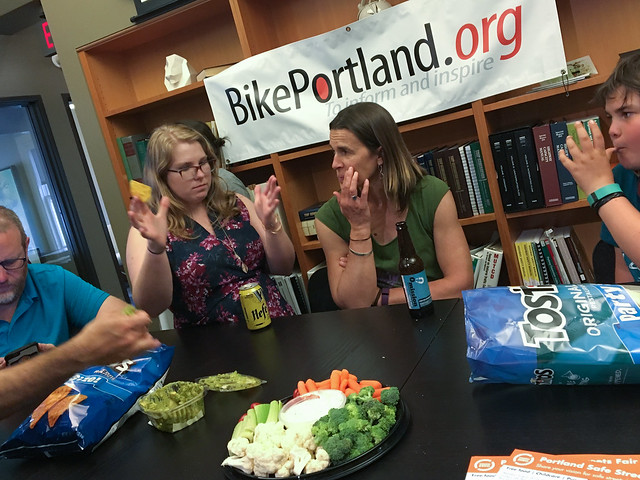
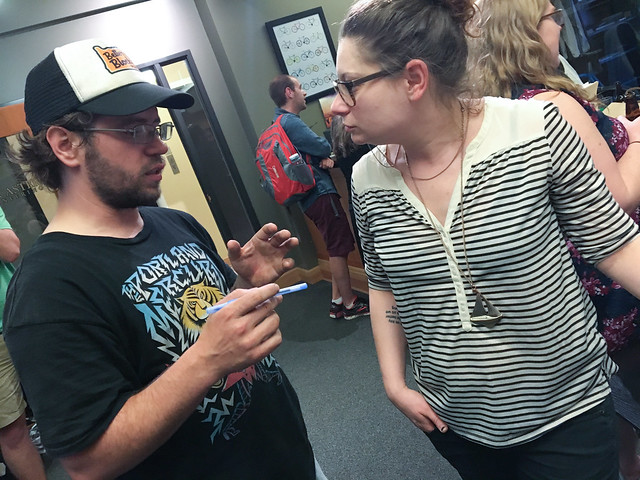
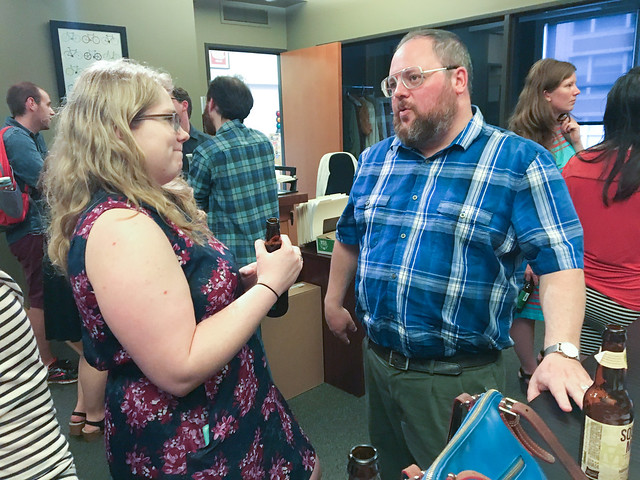
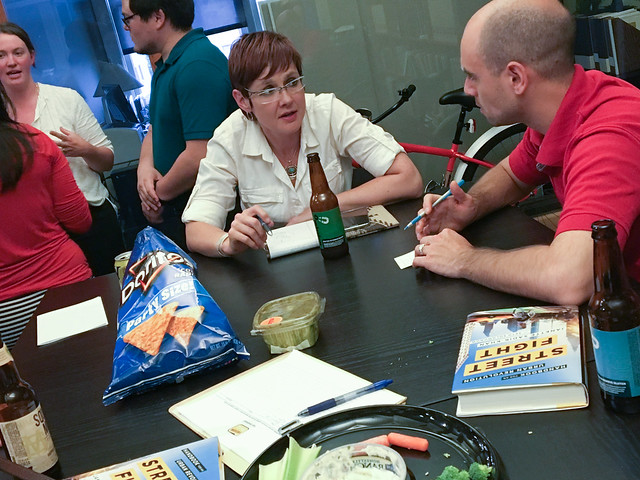
And the demand for sane, people-oriented streets isn’t just a Portland thing. Naomi Fast, a carfree Beaverton resident who commutes into Portland, encouraged us to take a more region-wide approach. A woman who works on Safe Routes to School programs in Tigard said people on the West Side are itching for events like Sunday Parkways and carfree street festivals.
If this movement is going to blossom in Portland and the spread across the region, we can’t just sit back and wait for it. We must organize, collaborate, and strategize. Basically, do what we’ve started to do, but do it better.
Speaking of which, we had several key leaders of Better Block PDX in the room. Gwen Shaw, Ryan Hashagen and Ben Chaney are three of the main organizers of the projects you’ve heard about like Better Naito and Better Broadway. They shared lessons learned from the Broadway project. Based on feedback from a local business improvement organization, they learned the most popular feature were the temporary crosswalks.
Raisman, the PBOT employee who’s an official liaison to Better Block, gave a lot of credit to Better Block and upstart bike activism group BikeLoud PDX. He said they’ve helped build a bridge between PBOT, the community, and other institutions.
Brian Davis, a traffic engineer and planner with Lancaster Engineering’s new StreetLab, said he can tell things are changing at PBOT. “I can see the needle moving in my conversations with them.” Davis said that PBOT staffers like Raisman and his fellow advocrat, bike coordinator Roger Geller, have telling the community to make more noise for a long time. “And we’ve been becoming louder thanks to BikeLoud and Better Block.”
When BikeLoud’s Soren Impey spoke up to question why PBOT doesn’t spend more money and resources to support Better Block projects, Raisman responded by citing budget realities.
“Oregon is one of the least taxed states in the country,” Raisman said. “We’re trying to cobble together as much as we can,” he continued. “And when money comes up major issues like homelessness, housing, and now lead, come up too. We have great neighborhoods and amazing people, that’s where our riches lie.”
Sarah Iannarone, fresh off her impressive mayoral campaign (she finished third with about 12 percent of the vote), was also at the event. She encourage the City to be more effective at how it leverages volunteer labor. “The thing that will keep us cutting edge is our community innovation. We need to orient public policy to empower the community.”
I asked Iannarone why she led her campaign with such a strong transportation reform platform. “I knew we couldn’t have a conversation about Portland’s future,” she said, “Without talking about our streets.”
After a rousing and inspiring discussion I asked everyone in the room to share their ideas for potential open streets projects. Here are some of the things that came up:
— Get cars off the “transit” mall
— Make a section of downtown carfree and base the plan on the Fareless Square boundary.
— A plaza at SE 26th and Clinton.
— Make the Park Blocks into some form of shared space where people are prioritized over cars.
— Create a world-class entertainment district instead of the “abysmal” situation in Old Town that exists today.
— Create temporary public plazas in work zones during construction projects (the streets are already closed so why not?)
— Stop giving away free parking.
We have momentum on our side, but there’s a lot of work to do. It all begins by bringing people together who are hungry for change and engaged and smart enough to make it happen. That’s what Wonk Night is all about.
If we embrace the opportunity to work with PBOT to make our streets better — instead of waiting around for them to do it for us — there’s no limit to what we can do together.
Thanks to everyone who showed up! Stay tuned to BikePortland, support groups and leaders who are transforming our streets, and let’s keep the momentum going.
Special thanks to our beer sponsors Widmer Brothers, Omission Beer and Square Mile Cider.
And thanks for bringing the cones Ryan!
— Jonathan Maus, (503) 706-8804 – jonathan@bikeportland.org
Our work is supported by subscribers. Please become one today.

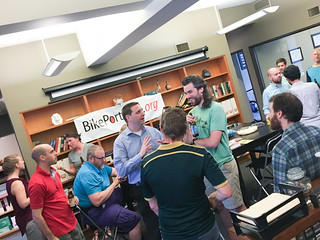
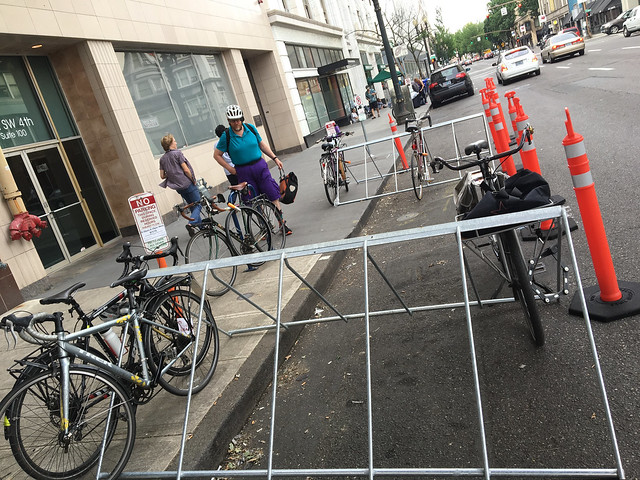
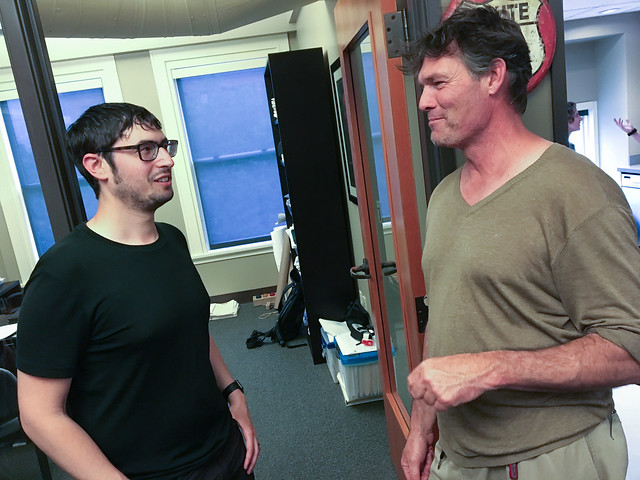
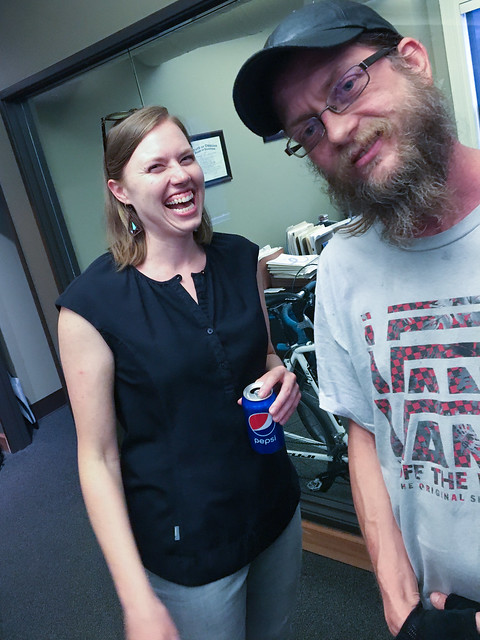
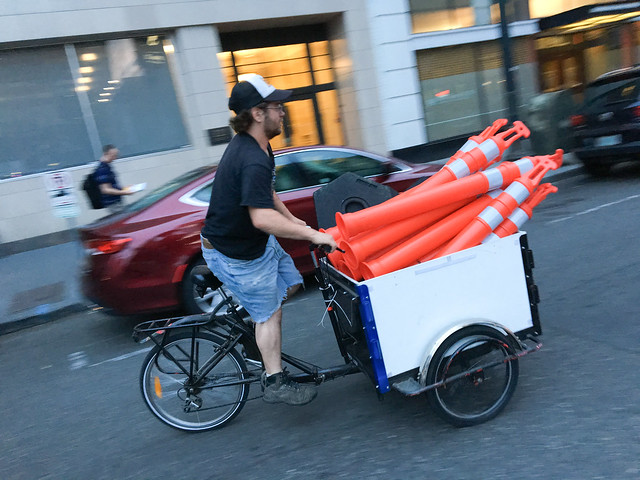
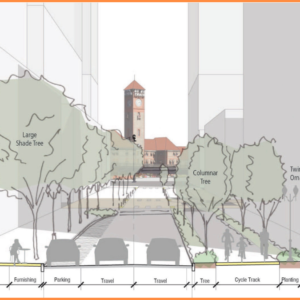
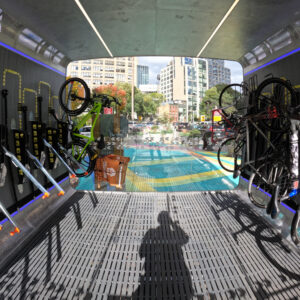
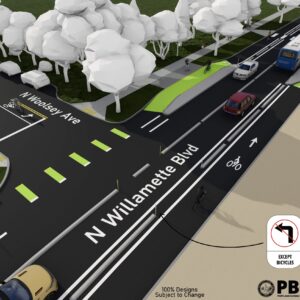
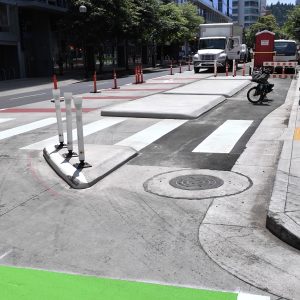
Thanks for reading.
BikePortland has served this community with independent community journalism since 2005. We rely on subscriptions from readers like you to survive. Your financial support is vital in keeping this valuable resource alive and well.
Please subscribe today to strengthen and expand our work.
I’m sad to have missed this one. I’ve commented here in the past about my efforts to work with the city via the Community Uses of Unpaved Streets program to create a woonerf style street in my neighborhood. PBOT has been very supportive and progress is ongoing. I hope that something can be on the ground soon, and I can share the process I worked through. Although my project is on an unimproved street, the policy I’m working under can potentially allow for neighbors to have a much stronger response to cut-through speeders, than just some fluorescent plastic children, even on paved neighborhood streets.
PBOT is currently hiring a consultant to streamline the process I’m going through, so this may be another tool in our toolkit, and something that could potentially reshape the traffic calming discourse in our neighborhoods completely.
Sorry to have missed you Chris. Been a long time. Glad to know you are still working on this project. I see it as yet another example of what I try to convey in this post… That if we the community embrace this opportunity to work in partnership with PBOT there’s no limit to what we can do. Can’t wait to hear more. Keep us posted and good luck.
In all honestly, I see this as a bad thing. The reason other cities have succeeded in this where Portland has continually failed is because their city government was properly invested in change and backed up the volunteers with real money. The fact that PBOT relies entirely on volunteers will eventually come back to bite us when the chronically understaffed and overworked volunteers get burnt out.
To be clear, I love what Better Block is doing to try to improve our streets. In order to take their success to the next level, we need proper investment from the city, and frankly, all I hear from city leadership is excuses why they can’t fund various projects.
You’re right. Portland seems to be in this never ending alpha phase as far as designs go.
As if our leaders are humoring the advocates and the one random city employee by letting them play with a couple blocks for a few months.
Other cities in the US, or anywhere? Which other ones are successful, and what’s considered successful about them (compared to Portland)? (For the sake of discourse, not argument).
I hear you Adam. But a few thoughts: PBOT is supporting the efforts through permitting support and devoting top-level staff and expertise to the projects. I agree with you they could/should be doing more. And I think they will eventually… But there’s also a neat opportunity here: because this is citizen-led we actually have more freedom and can do even more innovative things than if the city were in the way. Right? Think about it: would you rather have a city writing checks for safe things or saying, basically, “go ahead and dream big! We can’t fund you but we won’t stop you from trying.”
Another point to consider: citizens who frequently walk or ride bicycles often know more about the traffic patterns and infrastructure problems than the planners/engineers assigned to address them, who rarely are people who walk/bike in those locations often (and sometimes have never even visited them!). I’ve had reasonable luck addressing one small problem at a time in the pragmatic manner that Wells suggests (http://bikeportland.org/2016/06/03/wonk-night-recap-exciting-times-for-open-streets-184914#comment-6670105). Of course, coordinated multi-pronged approaches are most effective, including vision-level programs like Better Blocks.
Lots of folks in different places are watching y’all for ideas, so keep on doin watcha doin! 🙂
Pete, with your comment in mind, I have a special request for everyone here… I’ve been dreaming of a big ride in Washington County. Playing with calling it “Secrets of Suburbia” “Experience the Possible” or the “Show Don’t Tell” ride. The suburbs won’t always be lonely for active commuters, but at the moment, I miss seeing PDX numbers of bikes. I’d love help seeing this ride happen! I’m picturing a huge walk/ride/wheelchair roll around Nike.
Couple options to get to Nike from PDX. For those just getting in bike shape, or those on foot or in a wheelchair, the Beaverton Creek MAX places you right at the new Nike woods trail. For those in great shape: Bike over the west hills -or- hop off MAX at Sunset. From there bomb down the hill (fun!!!), ride along SW Park Way & end up at the Walker & Murray corner of the Nike campus.
And I’d love to lead a segment from Beaverton Transit Center to show those who’ve never ridden in WashCo a car-lighter bike way to Nike. All groups could circle the Nike perimeter till we’ve all joined up. From there we could MAX/bike on to downtown Hillsboro for food (Amelia’s is good!). Even ten people walking & biking along Murray’d be a sight for Nike & WashCo neighborhoods, but I’m thinking bigger…
What do people think—would this work best as a Pedalpalooza ride? Something separate? Definitely summer, I think, for the long daylight hours.
Road engineers contracted to design WashCo roads, if you’re reading this: You’re invited to join us. Having chatted with some of you at open houses, I know you haven’t all ridden in bike lanes next to 45mph cars. Join us, for the chance to experience your road designs by bike in a group setting & receive great feedback (see Pete’s comment above).
We could have the pothole crews install bollards instead and be at over 25% bike mode share in a year or two.
I think the drive to get it done needs to come from the people. That’s really what we’re missing — most people want to talk about more parking and also flashing crosswalks so they don’t have to pay attention so much.
..and green paint, because that’s the most common ‘solution’ to bike safety that I see frequently proposed at meetings attended mostly by people who don’t actually bike.
Hi Adam,
I’ve been working on a project since early March, formally asking the city for new effective policy related to these issues. I’m collecting formal input from community advocates, and I’d like to hear more about what you commented. Please email me if possible.
Thanks – Melinda
All I want is to see a half dozen streets get turned into carfree streets downtown:
Park
2nd
Flanders
Stark
Yamhill
Columbia
Think about how much easier and safer and happier it would be to get around downtown if the streets belonged to the people instead of to cars.
Pick one, I’d say Flanders, request a sidewalk outline map from the city, (basic google satellite photos with defined curb edges). Your job is to lay in BOTH bike and pedestrian elements, lanes, crosswalks, obstacles, etc. Enlarge a copy for hand editing with whiteout and new lines.
(that’s how I do it. More real, less computer-y). (^:
Make a point to REMOVE parking spots near any intersection.
Pedestrian visibility of approaching vehicles the prime safety feature.
At specific places ped/bike interaction requires specific bikeway alterations. We should debate the width and design of curb ‘bumpouts’ when their curb extends into a ‘could-be’ bike lane.
Do all that first then visions would be less hazy.
You can download the curb edges data set (and many others) here. http://www.civicapps.org/datasets
Yes! I also use GoPro video (and screenshots), showing typical traffic patterns/behavior to help with the rationale for things I propose. I did this here (https://goo.gl/maps/ZHviQtMnHe52) and managed to get them to put in a dedicated right-turn only lane, whereas they originally planned this ginormous painted bump-out, like the one they did here: https://goo.gl/maps/u5FXMSj3S7t (which tends to direct cyclists into the fenders of the cars pulling in and out of that post office).
(Unfortunately, in the first link you’ll notice the cyclist is then directed back to the far right, which obscures them from drivers pulling out of the next road. I argued blue in the face to keep the bike lane straight with a 1′ painted buffer like it is on much of this roadway, but the engineer claimed a cyclist there may be hit by a driver merging from a right-on-red at Bobwhite (a low-traffic street). “No right turn on red sign?”, I replied, but some fights you just don’t win…).
Anyway, keep fighting your good fight! 🙂
I remember reading a book set in Pakistan. (The book was fictional, so the setting may have been inaccurate, but it struck me as a brilliant idea.) The city in which the action took place had gates across the streets that were closed in the evening, which turned the downtown into a large car-free area with lots of outdoor seating at the restaurants. In the morning, the gates open and the cars return to do their (awful) thing.
It’s only half a loaf, but that’s more satisfying than nothing.
I’ve personally seen this for many older European city centers. Maastricht, Netherlands & Le Mans, France both use bollards that rise up from the street, instead of a gate, but the same idea, and close off a vast area, opening it up to pedestrians and bikes moving wherever, from about 4 pm to midnight. York, Chester & Exeter, UK, and Siena Italy, ancient Roman cities all, have nearly complete circuits of medieval city walls, with severe traffic restrictions during the day and evening; only at night are delivery trucks allowed. York even bans bikes in the evening in its commercial center, to allow pedestrians unrestricted access and enjoyment.
I look forward to the day that Portland can stop celebrating it’s temporary projects and take price in it’s permanentl accomplishments.
I’m not a leader, and anything but an extrovert, but if I can push the would-be leader to be better, maybe it’s time to start at least being present at these events.
pride / permanent
The cazadores seems to be overriding my spell check.
Become a leader, follow your passion.
Request a sidewalk outline map from the city, (basic google satellite photos with defined curb edges). Your job is to lay in BOTH bike and pedestrian elements, lanes, crosswalks, obstacles, etc. Enlarge a copy for hand editing with whiteout and new lines.
(that’s how I do it. More real, less computer-y). (^:
Make a point to REMOVE parking spots near any intersection.
Pedestrian visibility of approaching vehicles the prime safety feature.
At specific places ped/bike interaction requires specific bikeway alterations. We should debate the width and design of curb ‘bumpouts’ when their curb extends into a ‘could-be’ bike lane, example NW 9th & Irving. Do all that first for visions that would be less hazy.
Great event with inspiring people! I have to say, that was a first for me, to get a round of applause for being car free! Thanks—it felt pretty nice 🙂 I’ve lived in the suburbs in a zero-car household (of two adults) since 2013, with help from MAX & Zipcar. I also “run commute” to the library & shopping. That is, I literally run to the store & carry bags home by MAX & walking. (For bigger loads I bike; for Costco-sized loads, bike & trailer.)
I’m very excited livability is being addressed in earnest by all of us. Since moving to the suburbs I find I’m becoming less tolerant of the wearying noise & smell of cars, & their overwhelming presence—oil train fires diminish my tolerance that much more. I predict our grandchildren will be amazed we kept cars inside our house structures.
I like how we started this evening out by telling our livability or car-free/car-light experiences. Along with using transit & enjoying car-free Sunday streets in Brussels, part of my life story is that till I was almost 12, I grew up in a remote part of DRC (then known as Zaire, where “When We Were Kings” is set. Great film about Muhammad Ali; see it if you can!).
Where I lived we had no running water, electricity (other than a solar panel generator for the hospital), phones, or cars, so to me, being less dependent on motorized vehicles feels like a return to something perfectly natural. This is to say: The more our kids get to experience traveling to school, the store, etc, OUTside of cars, the more normal & natural it will feel to them all their lives.
After returning to the U.S., my family became car-dependent again. By the time I moved to Portland in 2003, I was as entrenched in car-dependency as any American & drove a ’94 Ford Thunderbird. Pretty soon I met this guy who didn’t have a car. In ’05 he taught me to city ride on my first bike since the one I rode in Africa. Freedom! In Jan 2010, I sold my car (it was mostly clutter by then & an undesired expense). I highly recommend coming to bike commuting for love & friendship!